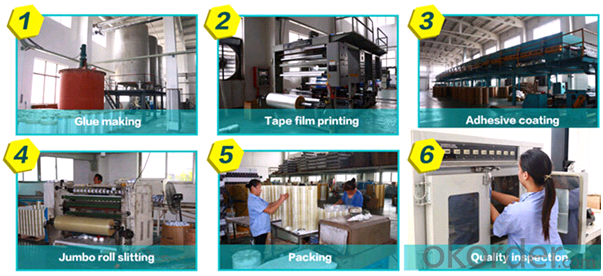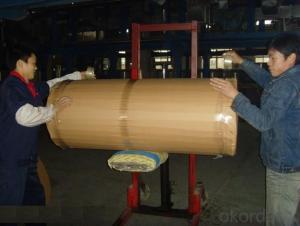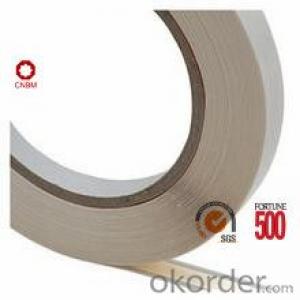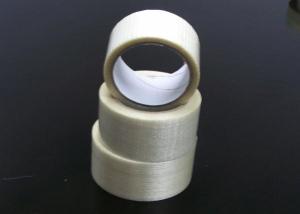Adhesive OPP Packaging Tape - 40Micron High Quality Circle Tape Wholesale
- Loading Port:
- Shanghai
- Payment Terms:
- TT or LC
- Min Order Qty:
- 10000 m²
- Supply Capability:
- 20000000 m²/month
OKorder Service Pledge
OKorder Financial Service
You Might Also Like
Opp Tape Wholesale 40micron High Quality Circle Tape
1. Structure of Bopp Tape Description
The Bopp Tape is of Bopp film as the carrier, coating with water based acrylic adhesive. It is excellent in flame retardant, high temperature stability, and anti-aging. It provides well insulation to various products.
2. Main Features of Bopp Tape
Good adhesive and quality
High tensile strength, Good elongation
Competitive price, manufacturer
OEM with any sizes and colors
Light, non-toxic, tasteless, environment-friendly
3. Bopp Tape Images



4. Bopp Tape Specification
Item No. | Thickness (micron) | Initial Tack (stell ball) | Adhesion to Steel (N/25mm) | Holding Power (hour) | Tensile Strength (N/625px) | Elongation at Break (%) |
BP-40 | 40 | >18# | 5 | >24 | >30 | <180 |

5. FAQ
Q1. What is the specification and packing for Bopp Tape?
Specifications:
1) Length: 3,000m, 4,000m, 6,000m
2) Width: 980,1020,1040,1255,1270,1280,1320,1600,1620mm
3) Thickness:35-70mic,depends on customers requests
Packaging: Bubble pack, then kraft wrap
Q2. What is the Applications?
1) Used for packaging, bunding, wrapping, gift wrapping etc
2) Medium & Heavy Carton sealing, box sealing, bag sealing
3) Sealing all bags, steadying and bundling, protection, decoration
Q3. What kind of service we can provide?
Professional consultation on your local market
Your inquiry will be replied within 12 hours.
24 hours service for you
Satisfactory sales service
Free samples
- Q: Does packaging tape have any specific safety precautions?
- Yes, packaging tape does have some specific safety precautions that should be followed. Firstly, it is important to handle packaging tape with care and avoid any sharp or sudden movements that could cause injury. While packaging tape itself is not typically dangerous, mishandling it could result in cuts or punctures. Additionally, it is essential to use the appropriate type of packaging tape for the intended purpose. Different tape materials and adhesives are designed for various applications, such as sealing boxes or securing heavy items. Using the wrong type of tape may result in inadequate sealing or potential hazards. Furthermore, it is crucial to store packaging tape in a safe place away from extreme temperatures, moisture, or direct sunlight. These factors can affect the tape's adhesive properties and compromise its effectiveness. Lastly, when using packaging tape, it is advisable to wear protective gloves if necessary, especially when handling sharp or heavy objects. This can provide an extra layer of safety and prevent any potential injuries. By following these safety precautions, users can effectively utilize packaging tape while minimizing the risk of accidents or harm.
- Q: What are the benefits of using high-visibility packaging tape?
- The benefits of using high-visibility packaging tape include improved visibility of packages, reduced risk of mishandling or misplacement, increased safety during transportation, and enhanced brand recognition and professionalism.
- Q: Is packaging tape safe for use on children's toys or products?
- Directly using packaging tape on children's toys or products is not recommended. Although packaging tape is commonly used for sealing packages, it is not intended or tested for contact with children's skin or for use on items that may come in contact with their mouths or eyes. To ensure the safety of children, toys and products for children must adhere to specific safety regulations and guidelines. It is crucial to follow the manufacturer's instructions and use materials specifically designed for children's toys and products, such as non-toxic adhesives or child-safe tapes.
- Q: How does packaging tape adhere to surfaces?
- Packaging tape sticks to surfaces by utilizing adhesive materials that are typically made from synthetic rubber or acrylic-based substances. These materials are specifically engineered to possess a strong bonding capability with a variety of surfaces, including cardboard, plastic, and metal. The adhesive on packaging tape functions by establishing a connection between the tape and the applied surface. When pressure is exerted on the tape, the adhesive substance spreads out and establishes contact with the surface. This contact enables the adhesive to interact with the molecules of the surface, resulting in the formation of a bond through intermolecular forces. The most commonly employed type of adhesive found on packaging tape is known as pressure-sensitive adhesive (PSA). PSA is specifically formulated to adhere to surfaces with minimal pressure. Upon the application of pressure, the adhesive substance flows and conforms to the surface, ultimately creating a robust bond. Furthermore, the adhesive on packaging tape is designed to withstand various environmental factors such as temperature, humidity, and moisture. This ensures that the tape remains firmly adhered to the surface, even in challenging conditions. In conclusion, packaging tape adheres to surfaces by utilizing adhesive materials, typically synthetic rubber or acrylic-based. These adhesives establish a bond between the tape and the surface through intermolecular forces, allowing the tape to securely stick.
- Q: How does packaging tape perform in high-temperature conditions?
- Packaging tape generally performs well in high-temperature conditions, but its effectiveness may vary depending on the specific type and quality of the tape. Most packaging tapes are designed to withstand a range of temperatures and are typically heat-resistant up to a certain degree. However, it is important to note that extreme temperatures, particularly those exceeding the tape's specified heat resistance limit, can affect its adhesive properties and overall performance. In high-temperature conditions, the adhesive on packaging tape may soften or weaken, leading to reduced bonding strength and potential tape failure. This can result in packages opening or becoming less secure during transit or storage. Furthermore, heat can cause the tape to become less flexible, making it more prone to cracking or breaking. Hence, it is crucial to select packaging tape that is specifically designed for high-temperature environments if you anticipate exposure to extreme heat. Certain types of packaging tape, such as fiberglass-reinforced or high-temperature resistant tapes, are better suited for withstanding high temperatures. These tapes are often made with special adhesives and materials that offer enhanced heat resistance and improved performance in extreme conditions. They are designed to maintain their adhesive strength, bonding capability, and structural integrity even when exposed to elevated temperatures. In summary, while packaging tape can generally withstand high-temperature conditions, its performance may be compromised if subjected to extreme heat. Using tapes specifically designed for high-temperature environments can help ensure optimal performance and securely seal packages even in challenging conditions.
- Q: Can packaging tape be used for other purposes?
- Yes, packaging tape can certainly be used for other purposes beyond its primary use of sealing packages. Due to its strong adhesive properties and durability, it can be used for various other applications. One common alternative use of packaging tape is for organizing and bundling items together. Whether it's sorting cables and cords, securing loose items, or grouping similar items, packaging tape can effectively keep things neatly organized. It can also be used to secure items to walls or surfaces temporarily, such as posters or decorations, without causing any damage. Additionally, packaging tape can be utilized for crafting and DIY projects. Its adhesive nature makes it a great material for creating temporary or permanent bonds between different materials. It can be used to repair torn papers, create labels or tabs, or even make custom stickers. Its versatility and availability in different widths and lengths make it a handy tool for various creative endeavors. Moreover, packaging tape can be utilized for household fixes and repairs. From mending broken items to reinforcing weak joints, the strong adhesive properties of packaging tape can provide a quick and temporary solution. It can also be used to seal minor leaks or cracks temporarily until a proper repair can be made. In conclusion, while packaging tape is primarily designed for sealing packages, its strong adhesive properties and versatility make it suitable for various other purposes. Whether it's organizing, crafting, or quick fixes, packaging tape can be a useful tool to have on hand.
- Q: Are there any eco-friendly options for packaging tape?
- Yes, there are eco-friendly options for packaging tape available in the market today. Traditional packaging tapes are typically made from plastic materials such as polypropylene or PVC, which are not biodegradable and have a negative impact on the environment. However, eco-friendly alternatives have been developed to address this issue. Some options include: 1. Paper-based packaging tape: These tapes are made from renewable resources such as paper and natural adhesives. They are biodegradable, compostable, and recyclable, making them a sustainable choice for packaging needs. 2. Water-activated tape: Also known as gummed paper tape, this type of tape is made from paper and requires water to activate the adhesive. It forms a strong bond when applied to boxes and is tamper-evident. Water-activated tape is biodegradable and can be recycled along with the packaging it is applied to. 3. Biodegradable and compostable tape: These tapes are made from plant-based materials such as cellulose or PLA (polylactic acid). They are designed to break down naturally over time, reducing their impact on the environment. Some options are certified as compostable, meaning they can be added to compost piles or sent to composting facilities. 4. Recycled plastic tape: While traditional plastic tapes are not eco-friendly, there are recycled plastic tape options available in the market. These tapes are made from recycled plastic materials, reducing the demand for virgin plastic and promoting a circular economy. When looking for eco-friendly packaging tape, it is important to consider certifications such as the Forest Stewardship Council (FSC) for paper-based tapes or the Biodegradable Products Institute (BPI) certification for compostable tapes. By choosing these alternatives, individuals and businesses can minimize their environmental footprint and contribute to a more sustainable future.
- Q: What are the considerations for using packaging tape on temperature-sensitive items?
- There are several factors to consider when using packaging tape on temperature-sensitive items. To begin with, selecting the right type of packaging tape is crucial. Temperature-resistant tapes are specifically designed to withstand extreme temperatures. These tapes are made with materials that can endure high or low temperatures without losing their adhesive properties or distorting. It is important to choose a tape that is suitable for the temperature range the item will be exposed to during storage, transportation, or any other handling processes. Properly storing the packaging tape is also essential. Extreme temperatures can affect the tape's adhesive properties, making it less effective. It is advisable to store the tape in a climate-controlled environment, away from direct sunlight or areas with excessive heat or cold. This will help maintain the adhesive strength and overall quality of the tape. Additionally, ensuring that the surface is clean and dry when applying packaging tape to temperature-sensitive items is important. Moisture or dust particles on the surface can compromise the tape's adhesion and result in inadequate sealing. Preparing the surface properly will guarantee a secure and reliable bond between the tape and the item. Furthermore, it is crucial to consider the duration of exposure to extreme temperatures. If the item will be subjected to high or low temperatures for a long period, additional protective measures such as insulation or specialized packaging materials may be necessary to provide extra insulation. Lastly, testing the tape's performance before using it on temperature-sensitive items is essential. Conducting a small-scale trial or using a sample item can help determine if the tape is suitable for the specific temperature conditions. This will help identify any potential issues or limitations before using the tape on valuable or delicate items. In conclusion, by taking into account factors such as tape selection, proper storage, surface preparation, duration of temperature exposure, and performance testing, one can ensure the safe and secure packaging of temperature-sensitive items.
- Q: How do I prevent packaging tape from becoming too loose?
- Here are some helpful suggestions for preventing packaging tape from becoming loose: 1. Opt for high-quality packaging tape: Invest in packaging tape that boasts a strong adhesive. Inferior quality tapes tend to lose their stickiness quickly, resulting in loose packaging. 2. Ensure cleanliness and dryness of surfaces: Prior to applying the tape, make sure that the surfaces are clean and dry. Dust, moisture, or oil can weaken the adhesive and cause the tape to loosen. 3. Apply firm pressure: When sealing a package, exert firm pressure while affixing the tape onto the surface. Be sure to run your hand or a flat object along the length of the tape to ensure proper adhesion. 4. Utilize overlapping tape: Instead of using only a single strip of tape, overlap it by a few inches. This overlapping technique provides added strength and diminishes the likelihood of the tape becoming loose. 5. Avoid extreme temperature fluctuations: Extreme temperature changes can adversely affect the adhesive properties of packaging tape. Refrain from storing packages in areas with high humidity or extreme temperature variations, as this can cause the tape to loosen. 6. Strengthen with extra tape: If you are sealing a heavy or bulky package, contemplate reinforcing it with additional tape. Apply extra strips of tape across the sides or diagonally to provide supplementary support and minimize the risk of the tape coming loose. 7. Properly store packages: When storing packages, ensure they are stacked correctly and not subjected to excessive pressure or weight. Inadequate storage conditions can cause the tape to loosen over time. By adhering to these recommendations, you can effectively prevent packaging tape from becoming too loose, thereby guaranteeing that your packages remain securely sealed during transit or storage.
- Q: Can packaging tape be used for heavy-duty packaging?
- Yes, packaging tape can be used for heavy-duty packaging. There are different types of packaging tapes available in the market, including heavy-duty ones specifically designed to withstand the demands of heavy or bulky packages. These tapes are generally made with durable materials like reinforced fibers or strong adhesives that provide excellent strength and secure packaging. They are capable of holding together heavy and rigid boxes, preventing them from opening or tearing during transit. When choosing packaging tape for heavy-duty packaging, it is important to consider the weight and size of the package, as well as the specific requirements of the shipping or handling process.
Send your message to us
Adhesive OPP Packaging Tape - 40Micron High Quality Circle Tape Wholesale
- Loading Port:
- Shanghai
- Payment Terms:
- TT or LC
- Min Order Qty:
- 10000 m²
- Supply Capability:
- 20000000 m²/month
OKorder Service Pledge
OKorder Financial Service
Similar products
Hot products
Hot Searches




























